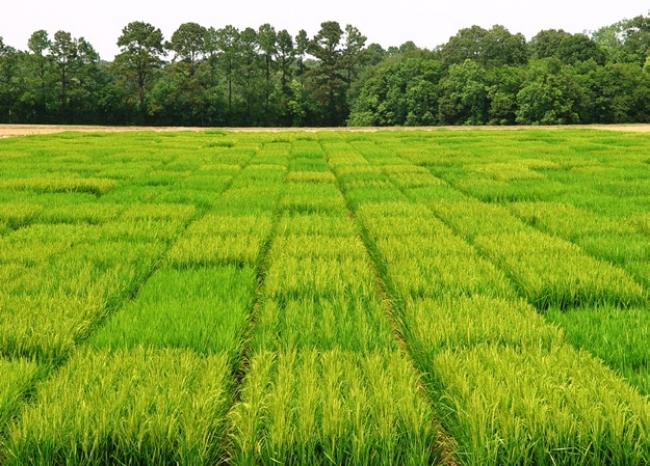
(Photos: Karen Bearb)
The development of rice varieties helps guarantee sustainable rice production in the state of Louisiana and elsewhere in the United States. Variety development is one of the missions of the Louisiana State University Agricultural Center (LSU AgCenter) Rice Research Station near Crowley, Louisiana.
To develop a new variety, the first step is to generate new genotypes (or genetic combinations) by crossing two different rice lines. More than 1,000 crosses are typically made at the Rice Research Station each year. The resulting seed—F1 or first generation—from these crosses will contain genetic information from both parents. This seed is then germinated to produce F1 plants. The seeds from these plants are planted during the next season to produce a population of segregating F2 plants, which display numerous combinations of traits from the two parents. Then, these plants undergo an important step of selection, in which breeders pick individual panicles that exhibit the best combination of critical traits.
From this point on (F3 to Fn), most of the breeding materials are grown as panicle (head) rows. A panicle row is a row of plants that all come from a seed taken off a single panicle produced from the previous generation. The best rows (not individual plants) will be selected to advance to the next generation. Each year, 95,000 to 110,000 panicle rows are grown at the Rice Research Station in various breeding projects. Each of these rows is a different genotype and, theoretically, any of them could become a new variety.
From the F4 to the F5 generation, lines from most of the crosses are already sufficiently uniform so their initial yields can be evaluated. Lines selected for potential yield evaluation are bulk-harvested.
During the following winter, each harvested sample is analyzed (for grain appearance and milling, cereal chemistry, and seedling vigor), and the superior lines go through preliminary yield tests. These trials are planted in late March and early April at the Rice Research Station. This allows a sufficient growing season to evaluate first- and ratoon-crop performance.
A regional endeavor
Lines with superior characteristics in preliminary testing are considered for commercial-advanced (CA) trials and a Uniform Regional Rice Nursery (URN). The CA trials are conducted at six to eight locations across Louisiana’s rice-growing regions. Meanwhile, the URN is a cooperative endeavor among the public rice breeding programs in Arkansas, Louisiana, Mississippi, Missouri, and Texas. The nursery is a yield-testing program conducted at the primary research location in each of those states. The same rice lines are tested at each of the five locations. The 200 entries in these tests are elite lines from each breeding program that the breeders think might have the attributes worthy of a new release. Each of the breeding programs contributes a number of lines to the testing program. The yield test is conducted at the research station in each state using the best management practices for that region, and current commercial varieties are included to provide a benchmark for comparison.
Lines that show good and stable yield, milling, and agronomic characteristics across all these diverse environments will be re-entered into these trials in the following year. A line that shows good potential as a future release will also be included in the statewide testing program to determine optimum nitrogen fertilization rates. In addition, these lines will be evaluated based on their responses to selected rice herbicides so that, if a line is released as a variety, a package of agronomic recommendations for its production can also be made available.
If a line displays significantly better performance than the current commercial varieties, seed increase will be expedited. The initial seed increase will be in headrow blocks that will be used to plant a breeder seed block. Seed from the breeder seed block will provide enough seed for up to a 20-acre (about 8 hectares) foundation seed field on the Rice Research Station. Foundation seed is then provided to the industry as the first step in the dissemination of a new variety.
Rice varieties
The two primary types of grain grown in Louisiana are long grain and medium grain. Long grains are characterized by a grain length-to-width ratio of more than 3:1 and they typically cook dry and fluffy because of a high to intermediate gelatinization temperature and they have relatively high amylose content. Medium grains typically have a length-to-width ratio of 2:1 to 3:1 (usually closer to 3:1) and they cook soft and sticky because of a low gelatinization temperature and relatively low amylose content.
In recent years, a majority of the southern U.S. has been planted to Clearfield varieties and hybrids. Therefore, much of the breeding effort in the program focuses on improving lines with this trait in both long- and medium-grain types.
Interest in special-purpose varieties has also increased in recent years. These varieties have distinctly different attributes, such as aroma, elongation, or unique cooking characteristics, favored by many ethnic populations living in the U.S. as well as by other consumers interested in gourmet or premium rice. The major specialty types are soft-cooking, aromatic Jasmine; flaky-cooking, elongating, and aromatic Basmati; Kokuho; waxy, standard long-grain aromatic Della; soft-cooking, non-aromatic Toro; and other lesser-known gourmet types. Most specialty rice marketed in the U.S. is imported from Thailand, India, and Pakistan. A number of specialty varieties Shafrom the Della, Toro, and Jasmine groups are under limited production in the southern U.S., but the recent releases of Jazzman and Jazzman-2 have greatly expanded the area of specialty varieties.
In the past 15 years, more than 60% of the rice area in the southern U.S. has been planted to varieties developed at the LSU AgCenter Rice Research Station. This includes conventional and Clearfield long and medium grains, as well as specialty types.
_________________________________________
Dr. Linscombe is a senior rice breeder and director of the Louisiana State Agricultural Center and Dr. Sha is a rice breeder and associate professor at the center.







